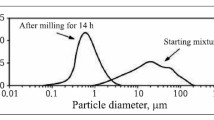Abstract
The behaviour of the two-phase ceramic system BeO-ThO2 as a function of thoria (ThO2) particle size and concentration was studied by measuring changes in strength and Young's modulus. Modulus of rupture measurements were made by the four-point bending of cylindrical specimens, and Young's modulus was calculated from the deflection of rectangular beams. Examination of matching fracture faces showed that cracks passed through thoria particles, indicating they were bonded to the matrix. At 1.6 vol % thoria, the strength of a dispersion depended on the thoria particle size; ∼5 μm particles caused little change from 33000 lb/in.2 (23.1 kg/mm2) for pure beryllia (BeO), while with ∼110 μm particles the strength was 20100 lb/in.2 (14.1 kg/mm2). The strength of 1.6 vol % ∼200 μm dispersions increased with test temperature in the range 20 to 400° C, indicating the presence of internal tensile stresses, caused by the differing coefficients of thermal expansion of beryllia and thoria. Increasing the concentration of thoria caused Young's modulus and strength to decrease; the observed values for Young's modulus agreed closely with those predicted for BeO-ThO2 dispersions using Hashin and Shtrikman's method. It is concluded that the strength of BeO-ThO2 dispersions is controlled by the strength of the weak thoria particles unless the particle size is restricted to less than 5 μm.
Similar content being viewed by others
References
D. P. H. Hasselman and R. M. Fulrath, J. Amer. Ceram. Soc. 48 (1965) 218.
D. B. Binns, Sci. of Ceram. 1 (1964) 315.
D. O. Nason, University of California Report UCRL 11011 (1963).
J. Selsing, J. Amer. Ceram. Soc. 44 (1961) 419.
B. Paul, Trans. Met. Soc. AIME 218 (1960) 36.
Z. Hashin, J. Appl. Mech. 29 (1962) 143.
Z. Hashin and S. Shtrikman, J. Mech. and Phys. Solids 11 (1963) 127.
W. H. Roberts, J. Nuclear Matls. 14 (1964) 29.
W. B. Rotsey, K. Veevers, and N. R. McDonald, AAEC Report TM305 (1966).
K. Veevers and W. B. Rotsey, AAEC Report TM290 (1965).
D. N. Turner and P. D. Smith, AAEC Report TM300 (1965).
J. W. Kelly, unpublished.
W. Weibull, Proc. Roy. Swedish Inst. Engng. Res. No. 153 (1939).
S. A. Bortz, Technical Document Report No. ASD-TR-61-628 (1962).
J. B. Wachtman, Jr. and D. G. Lam, Jr. J. Amer. Ceram. Soc. 42 (1959) 254.
J. W. Kelly, unpublished.
R. J. Hilditch, B. S. Hickman, W. B. Rotsey, and K. Veevers, J. Nuclear Matls. 20 (1966) 119.
Author information
Authors and Affiliations
Rights and permissions
About this article
Cite this article
Veevers, K., Rotsey, W.B. Mechanical properties of dispersions of thoria in beryllia. J Mater Sci 1, 346–353 (1966). https://doi.org/10.1007/BF00549932
Received:
Issue Date:
DOI: https://doi.org/10.1007/BF00549932




